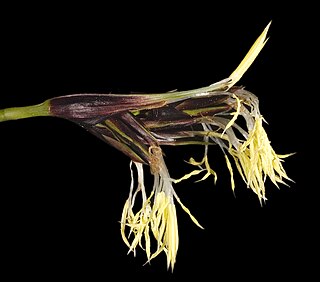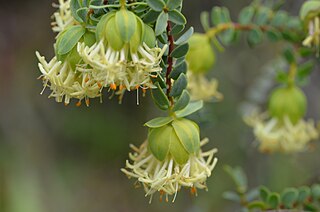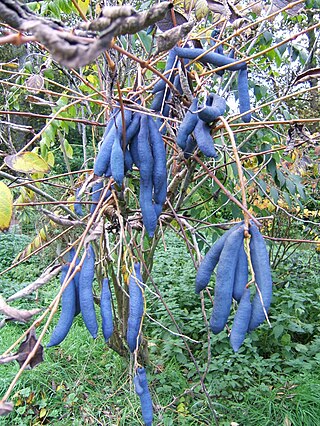
Cuscuta epithymum is a parasitic plant assigned to the family Cuscutaceae or Convolvulaceae, depending on the taxonomy. It is red-pigmented, not being photosynthetically active. It has a filiform habit, like a group of yarns. Its leaves are very small, like flakes. Its flowers, disposed in little glomerules, have a white corolla, with the androecium welded to the corolla.

Agelanthus is a genus of Afrotropical plants in family Loranthaceae. They grow in trees, including Acacia and Combretum species, as hemiparasitic shrubs of varying sizes. The host plant is penetrated by a single haustorium, and the stems typically have swollen, flower-producing nodes. The flowers are often closely clustered (fascicled) with the five petals (pentamerous) fused into a tube (gamopetalous). The flower may have a swollen base and the tubes open along unilateral, V-shaped splits. The filaments remain spirally rolled inward when the flowers open, while the styles are inconspicuous, slender filaments that are somewhat thickened in the middle. Berries range from pink to orange and red in colour, and are around 1 cm in diameter.
Agelanthus kayseri is a species of hemiparasitic plant in the family Loranthaceae, which is native to Kenya, Tanzania and Somalia.
Agelanthus keilii is a species of hemiparasitic plant in the family Loranthaceae, which is native to Rwanda, Tanzania and Burundi.
Agelanthus igneus is a species of hemiparasitic plant in the family Loranthaceae, which is native to Mozambique and Tanzania.
Agelanthus microphyllus is a species of hemiparasitic plant in the family Loranthaceae, which is native to Ethiopia, Kenya and Tanzania.
Agelanthus uhehensis is a species of hemiparasitic plant in the family Loranthaceae, which is native to Tanzania.
Agelanthus validus is a species of hemiparasitic plant in the family Loranthaceae, which is found in the Usambara Mountains, Tanzania
Agelanthus longipes is a species of hemiparasitic plant in the family Loranthaceae, which is found in the Tanzania, Mozambique and Kenya.
Agelanthus pennatulus is a species of hemiparasitic plant in the family Loranthaceae, which is found in Tanzania, and Kenya.
Agelanthus myrsinifolius is a species of hemiparasitic plant in the family Loranthaceae, which is native to Rwanda, Zaire and Burundi.
Agelanthus nyasicus is a species of hemiparasitic plant in the family Loranthaceae, which is native to Botswana, Malawi, Mozambique, Tanzania, Zambia, Zaïre and Zimbabwe.

Agelanthus natalitius is a species of hemiparasitic plant in the family Loranthaceae, which is native to the Cape Provinces, KwaZulu-Natal, Mozambique, the Northern Provinces, South Africa, Eswatini and Botswana.

Trachymene ornata, or spongefruit, is a slender annual herb in the family Araliaceae. It is native to Australia and found in Western Australia, South Australia and New South Wales.

Billardiera fusiformis is a species of plant in the family, Pittosporaceae, which is endemic to Western Australia.

Tetraria is a genus of flowering plants in the sedge family, Cyperaceae, native to Tanzania, South Africa, Borneo, Australia and New Zealand.

Pimelea sulphurea is a plant in the Thymelaeaceae family.

Livistona jenkinsiana is a species of fan palm in the family Arecaceae.

Decaisnea fargesii, the blue sausage fruit, blue bean shrub or dead men's fingers, is a member of the family Lardizabalaceae, and is native to Nepal, Tibet and China. It is a deciduous shrub which grows to 4 m tall and broad, but may achieve 8 m (26 ft) eventually.

Scaevola plumieri is a species of plant in the family Goodeniaceae which grows on coastal dunes in the tropics and subtropics.










